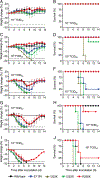Characterization of drug-resistant influenza A(H7N9) variants isolated from an oseltamivir-treated patient in Taiwan
- PMID: 25124927
- PMCID: PMC6943751
- DOI: 10.1093/infdis/jiu447
Characterization of drug-resistant influenza A(H7N9) variants isolated from an oseltamivir-treated patient in Taiwan
Abstract
Background: Patients contracting influenza A(H7N9) infection often developed severe disease causing respiratory failure. Neuraminidase (NA) inhibitors (NAIs) are the primary option for treatment, but information on drug-resistance markers for influenza A(H7N9) is limited.
Methods: Four NA variants of A/Taiwan/1/2013(H7N9) virus containing a single substitution (NA-E119V, NA-I222K, NA-I222R, or NA-R292K) recovered from an oseltamivir-treated patient were tested for NAI susceptibility in vitro; their replicative fitness was evaluated in cell culture, mice, and ferrets.
Results: NA-R292K led to highly reduced inhibition by oseltamivir and peramivir, while NA-E119V, NA-I222K, and NA-I222R caused reduced inhibition by oseltamivir. Mice infected with any virus showed severe clinical signs with high mortality rates. NA-I222K virus was the most virulent in mice, whereas virus lacking NA change (NA-WT) and NA-R292K virus seemed the least virulent. Sequence analysis suggests that PB2-S714N increased virulence of NA-I222K virus in mice; NS1-K126R, alone or in combination with PB2-V227M, produced contrasting effects in NA-WT and NA-R292K viruses. In ferrets, all viruses replicated to high titers in the upper respiratory tract but produced only mild illness. NA-R292K virus, showed reduced replicative fitness in this animal model.
Conclusions: Our data highlight challenges in assessment of the replicative fitness of H7N9 NA variants that emerged in NAI-treated patients.
Keywords: E119V; H7N9; I222K; I222R; R292K; ferrets; influenza virus; mice; oseltamivir; peramivir.
© The Author 2014. Published by Oxford University Press on behalf of the Infectious Diseases Society of America. All rights reserved. For Permissions, please e-mail: journals.permissions@oup.com.
Conflict of interest statement
All authors have submitted the ICMJE Form for Disclosure of Potential Conflicts of Interest. Conflicts that the editors consider relevant to the content of the manuscript have been disclosed.
Figures



References
-
- WHO. Number of confirmed human cases of avian influenza A(H7N9) reported to WHO. http://www.who.int/influenza/human_animal_interface/influenza_h7n9/14_Re.... Accessed 11 March 2014.
-
- WHO. Human infection with avian influenza A(H7N9) virus—update 2014. http://www.who.int/csr/don/archive/year/2014/en/index.html. Accessed 11 March 2014.
-
- Gao R, Cao B, Hu Y, et al. Human infection with a novel avian-origin influenza A (H7N9) virus. N Engl J Med 2013; 368:1888–97. - PubMed
Publication types
MeSH terms
Substances
Grants and funding
LinkOut - more resources
Full Text Sources
Other Literature Sources
Medical

